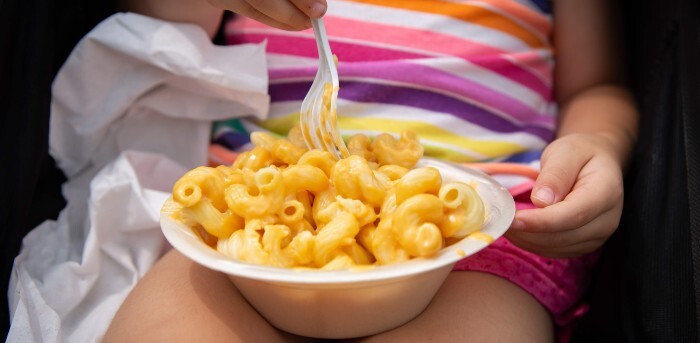Canadian … Cheese? The Strange Story of Kraft Dinner

For all you confused Americans who only know the term from late ‘90s MTV, Kraft Dinner is just what we call Kraft Mac & Cheese, but it’s right up there with maple leaves and universal healthcare as a Canadian national symbol. So how did that happen? Why did Canada go so gaga for processed cheese? Isn’t that our territory? Well…
It’s American

Sorry, Canada. Kraft Dinner was created by James Lewis Kraft in Chicago, which might be just across the lake from Canada, but it’s a pretty big lake.
It Does Have Some Canada

Mr. Kraft was, however, an Ontario native, some of Kraft Dinner’s ingredients are sourced from Canada, and Kraft Foods has a factory in Quebec. They have a lot more in the U.S., though.
It’s Technically Italian
Macaroni and cheese seems like a distinctly modern food with all its powders and cardboard, but the dish actually goes back to 14th-century Italy. Of course, back then, you had to spend all day rolling noodles and grating parmesan, but it was probably worth it.
Surprise Cameo From Thomas Jefferson

By the 18th century, macaroni and cheese made its way to England, specifically into the tummy of Thomas Jefferson, who introduced the dish to colonists in North America. He’s also responsible for bringing over ice cream and french fries, so like, he did some good stuff.
The Great Depression

Back to Kraft, who not only didn’t invent macaroni and cheese, he didn’t even invent boxed macaroni and cheese. That honor goes to a Scottish salesman living in St. Louis who started selling baggies of cheese rubber-banded to boxes of macaroni in 1930 because the Great Depressed would eat anything as long as it was cheap.
No Refrigerators
Another factor in the early popularity of boxed macaroni and cheese is that it required no refrigeration at a time when that was the situation in most houses. That’s right: We’re only about one human lifetime away from when we had to either eat food right away or master a whole new science to preserve it.
Patent Wars
Kraft also didn’t invent the concept of processing cheese so it doesn’t require refrigeration -- that was perfected by the Swiss five years earlier. In the grand American tradition of stealing from other countries, however, he did become the first to patent it. There was a reason he came here.
World War II

Kraft began selling his cheesy pasta to Canada and the U.S. at the same time in 1937, and he couldn’t have picked a better time. World War II soon broke out, and Kraft was selling his product for 19 cents a box at a time when most other methods of dairy consumption were tightly regulated. Speaking of which, it didn’t hurt that you could get two boxes for one ration coupon.
Popularity in Canada
While Kraft did alright in America, it really took off in Canada. Today, the country consumes about a quarter of all the Kraft macaroni and cheese in the world, which is about 55% more than Americans, and it’s the most popular grocery item in the country.
Canada’s Love of Cheese

But why? Believe it or not, Canada’s thirst for cheese is greater even than America’s. This is, after all, the land of poutine. Their dairy industry goes all the way back to the early 1600s, and Kraft actually grew up on a dairy farm and came to America to start a wholesale cheese business to unload all this cheese.
Made in Canada
Kraft could also technically market his product as an authentically Canadian experience, since he and some of his ingredients came from Canada, at a time when patriotism was at a record high. They fought too, you know.
Marketing to Adults

That’s not the only way Kraft markets differently in Canada. In America, boxed mac and cheese is seen as a step above baby food, so its marketing efforts are aimed at children and tired parents, but Canadians of all ages proudly enjoy Kraft dinner. Savor it, Americans. You’re more sophisticated for once.
Canadian Variations

Another important part of the “Kraft Dinner cult” of Canada is the country’s special relationship to the instructions on the box, which is largely estranged. “Research … showed most Canadians ignore the instructions believe that they have a unique way of making” Kraft Dinner, such as varying the amount of liquid or adding ingredients, most commonly hot dogs and/or ketchup. Possibly “all the fanciest Dijon ketchups.”
Barenaked Ladies

If you’re an American over 30 and you already knew the term “Kraft Dinner,” odds are it’s because you lived through the folk rock explosion of the ‘90s that included bands like Barenaked Ladies. After name checking the brand in their song “If I Had $1,000,000,” it’s become so much a part of their brand that fans at their shows throw boxes of pasta instead of panties.
Kraft Breakfast

Kraft’s latest marketing stunt, however, was aimed at Americans. In the early days of the COVID-19 pandemic, Kraft started insisting its “dinner” could be served with bacon, sausage, and/or eggs to become “Kraft breakfast.” To be fair, they did it because 56% of us said we’d been serving our kids boxed macaroni for breakfast more often lately, so disembark that shiny new high horse. This one’s on us.
Top image: April Walker/Unsplash